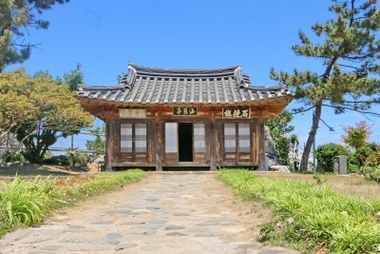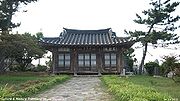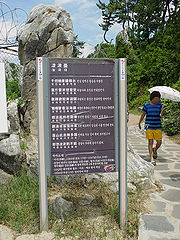동해 추암과 해암정
| 북평해암정 | |
|---|---|

| |
| 지정 번호 | 강원도 유형문화재 제63호 |
| 지정일 | 1979년 5월 30일 |
| 지정 명칭 | 북평해암정 |
| 한자 명칭 | 北坪海岩亭 |
| 영문 명칭 | Haeamjeong Pavilion, Bukpyeong |
| 분류 | 유적건조물 / 주거생활/ 조경건축/ 누정 |
| 건립·제작 | 조선시대 |
| 주소 | 강원 동해시 촛대바위길2 (북평동) |
| 위도 | 37.479052 |
| 경도 | 129.159046 |
| 웹사이트 | 문화재청[1] |
목차
Haeamjeong Pavilion
이 정자는 처음에 고려시대의 학자 심동로(沈東老)가 강학(講學)과 휴식의 용도로 만들었다.
This pavilion was first built by Sim Dong-no (f. 1361), a Goryeo era (918-1392) scholar, for use as a study hall and resting place.
심동로는 삼척 심씨의 시조이다. 그는 고려 공민왕 10년(1361)에 낙향하여 이 정자를 지었다.
Sim Dong-no is the progenitor of Samcheok Sim clan. He retired to his hometown in the 10th year of King Gongmin's reign(1361) and built it.
그러나 첫 가옥은 소실(燒失)되었고, 이후 조선시대 중종 25년(1530)에 심동로의 후손 심언광(沈彦光)이 중건(重建)했다.
The first house, however, was destroyed by fire, and later on was rebuilt by Sim Eon-gwang, a descendant of Sim Dong-no, in the 25th year of King Jungjong(1530) during Joseon Dynasty.
정의
추암(湫岩)과 해암정(海岩亭)은 둘 다 강원도 동해시에 위치하고 있다.
Both Chuam [Ch'u-am] and Haeamjeong [Hae-am-jung] are located in Donghea City, Gangwon province.
추암(湫岩)의 의미는 '촛대 바위'이다. 그 바위의 이름을 따라 지은 추암 해수욕장에서 그 촛대바위를 볼 수 있다. 따라서 추암은 바위 자체와 해수욕장 둘 다를 가리킨다.
Chuam 湫岩 means the 'Candlestick Rock.' You can see the Candlestick Rock at Chuam Beach, named after the rock. So Chuam refers to both the rock itself and the beach.
해암정(海岩亭)의 의미는 '바다 바위 정자'이다. 겉으로 보면 정자라기보다는 목조 가옥 형태에 더욱 가깝다. 그 건물 뒷편에서 바다에 있는 다양하고 멋진 모양의 바위를 볼 수 있다.
Haeamjeong 海岩亭 means the 'Sea Rock Pavilion.' But its apparent figure looks more like a wooden house rather than a pavilion. From the rear of the structure, you can take a view of the various amazing shapes of rocks in the sea. [2]
위치
내용
추암(湫岩)
추암과 그 이름
추암은 적적한 백사장이 있는 해수욕장이다.
Chuam is a quiet sandy beach.
추암이란 이름은 주변의 바다에 뾰족하게 솟아있는 촛대바위에서 유래했다.
The name 'Chuam' comes from a rock in the sea, which looks like a candlestick.
추암은 그 바위 절경으로 인해 1463년 조선시대 도체찰사(都體察使)였던 한명회가 "능파대(凌波臺, 문자적으로는 '성난 파도를 보는 누대')"란 이름을 붙이기도 했다. 그러나 이 경우 그가 의도했던 의미는 "미인들이 걷는 무대"였을 것이다.
Due to its superb view, it was also called Neungpadae (lit. "Observation Deck of the Billows") by Han Myeong-hoi, a supreme commander in 1463 during Joseon Dynasty. By Neungpadae, he meant "The Stage where the Beauties Walking." [3]
추암과 그 경치
그다지 광활하지는 않지만 촛대바위와 같은 멋진 기암기석(奇巖怪石)과 멋진 일출(日出)을 볼 수 있다.
The beach is not that spacious, but commands a fine view of odd-shaped stones and the beautiful sunrise over the ocean.
그 일출광경이 얼마나 아름다웠으면 애국가 첫 소절 "동해물"을 대표하는 영상으로 삼았을까!
It was so wonderful that the sunrise became the one of the first scenes representing the South Korea in the video clip of the National Anthem! [4]
본래 '능파대(凌波臺)'에서 ‘능파’란 ‘거센 파도’를 의미한다. 하지만 여기 이 경우에는 다른 의미로 사용되었는데, 그것은 ‘미인의 걸음걸이’를 뜻한다. 곧 그는 바위들이 마치 '미스 유니버스' 선발대회에서 사뿐히 걷는 미인들의 모습과 같다고 비유한 것이다.
The word 'Neungpa' in Neungpadae means ‘the Billows.' But here it has a different meaning which is 'walking on top of the waves,' implying beautiful women's walk. That is, he compared the rocks on the sea to Miss Universe contestants walking on the stage. [5]
어쩌면 그 모습이 바이런이 묘사했던 여인의 모습과 닮지는 않았을까.
Perhaps it would be like a woman as described by George Byron.
She walks in Beauty, like the night
그녀가 아름답게 걸으니
Of cloudless climes and starry skies;
구름 한 점 없는 밤같고, 별 가득한 하늘 같도다
And all that's best of dark and bright
명암으로 이루어낼 수 있는 모든 최상의 것이
Meet in her aspect and her eyes:
그녀의 얼굴과 눈길 속에서 만났도다
추암과 그 한시
조선시대 4대 문장가 중 한 사람인 이식(李植, 1584~1647)은 추암에 관한 한시를 지었다. 시의 형식은 칠언율시(七言律詩)이다.
Yi Sik (1584~1647), one of the four great writers during Joseon Dynasty, composed a Chinese poem about Chuam. Its form is a heptasyllabic lüshi (regulated verse). [6]
次凌波臺韻 (차능파대운) 이식(李植, 1584~1647)
Poem Matching the Verses of “Observation Deck of the Billows”
千仞稜層鏤積氷 (천인능층루적빙) 천 길 솟은 모난 절벽층은 쪼아서 [하늘 높이] 쌓아올린 얼음 조각 같다.
Precipitous cliffs went up for thousands of miles like chiseled ice piled-up [high up in the sky]
雲斤雷斧想登登 (운근뇌부상등등) 구름 자귀, 천둥 도끼를 “탕탕” 울리며 쪼아댔겠지.
It seems that they were made by cloud hatchets and thunder axes.
散蹄欲駐奔淵驥 (산제욕주분연기) 달리는 말발굽은 쉬고 싶은데도 거친 물처럼 달리는 천리마
Galloping hooves need rest, but the swift horse runs like a swirling water
褰噣驚看浴海鵬 (건주경간욕해붕) 벌어진 입과 놀란 눈으로 본다. 목욕하는 붕새를.
It gapes at Peng, the giant bird, bathing in the sea.
順浪高吟思謝傅 (순랑고음사사부) 물결을 따라 [폭풍 속에서 평정을 유지했던] 사안(謝安)을 생각하며 높이 기리고
Along with the waves, I praise Shifu Xie An's character by thinking of his inner peace [amid the tumultuous storm at sea]
觀濤奇筆憶枚乘 (관도기필억매승) 파도를 보며 매승(枚乘)의 기이한 붓을 떠올린다.
Observing the billows, I recall Mei Cheng's exceptional writing.
蓬山此去無多路 (봉산차거무다로) 봉래산(선경)도 여기서 가면 먼 길이 아닐 텐데
Peng Shan, a realm of immortals, is not far to go from here,
却恐凌波到不能 (각공능파도불능) 거센 파도가 두려워 도달할 수 없겠구나
But being afraid of the billows, I can't get there. [7]
추암과 그 이야기
뿐만 아니라 그 촛대 바위는 전설도 간직하고 있어서 더욱 주의를 끈다.
Besides, the Candlestick Rock has a folk tale, which also attracts our attention.
나는 이 이야기를 각색하여 "음향과 분노"라는 제목을 붙여보았다. 왜 그렇게 이름지었는지 곧 알게 되리라.
The story was adapted and titled the "Sound and Fury" by me. You will see why I named so.
그 이야기를 알고 싶다면, 다음 "촛대바위전설" 을 클릭하시라.
Click on the following link "Folk Tale About the Candlestick Rock" if you want to know the story. [8]
추암과 그 위치
추암 촛대바위는 그 위치 또한 흥미롭다.
Plus, Chuam is located in an interesting place.
바다를 향해서 설 때, 바위를 중심으로 왼쪽이 동해시, 오른쪽이 삼척시로서 두 지역의 경계가 된다.
Facing the sea, the left side of the rock is Donghae City and the right side of it is Samcheok City. It serves as a boundary of the two cities. [9]
해암정(海岩亭)
해암정은 과거에 동해시 북평동에 있었다. 그래서 북평해암정(北坪海巖亭)이라고도 불린 것이다. 이젠 행정구역 개편으로 촛대바위길2에 속해있다. 위치는 여전히 동일하다.
Haeamjeong was located in Bukpyeong Dong, Donghae City in the past. That is why it is sometimes called Bukpyeong Haeamjeong.
Now it belongs to Chotdaebawi Gil 2 due to the reorganization of the administrative districts, even though it still remains in the same place. [10]
해암정과 그 연혁
이 정자는 처음에 고려시대의 학자 심동로(沈東老)가 강학(講學)과 휴식의 용도로 만들었다.
This pavilion was first built by Sim Dong-no (f. 1361), a Goryeo era (918-1392) scholar, for use as a study hall and resting place.
심동로는 삼척 심씨의 시조이다. 그는 고려 공민왕 10년(1361)에 낙향하여 이 정자를 지었다.
Sim Dong-no is the progenitor of Samcheok Sim clan. He retired to his hometown in the 10th year of King Gongmin's reign(1361) and built it.
그러나 첫 가옥은 소실(燒失)되었고, 이후 조선시대 중종 25년(1530)에 심동로의 후손 심언광(沈彦光)이 중건(重建)했다.
The first house, however, was destroyed by fire, and later on was rebuilt by Sim Eon-gwang, a descendant of Sim Dong-no, in the 25th year of King Jungjong(1530) during Joseon Dynasty.
그 건물도 세월이 지나 낙후(落後)되니, 그 건물은 정조 18년(1794) 다시 중수(重修)되었다.
Since the structure was getting dilapidated as time passed, it was remodelled in the 18th year of King Jeongjo(1794).
현 건물은 1970년대에 다시 보수되었고, 1979년에 강원도 유형 문화재 제63호로 지정되었으며, 삼척 심씨(三陟 沈氏) 종중(宗中)에서 관리하고 있다
The present building was reconstructed during 1970's and designated as Gangwon Tangible Cultural Property No. 63 in 1979. It is now being maintained by Samcheok Sim clan. [11]
해암정과 그 건축
건물은 평지보다 높은 곳에 서있고, 크기는 정면 3칸, 측면 2칸이다. ‘칸’이란 두 기둥 사이의 공간을 가리키는 전통 길이 단위를 말한다.
The structure stands on the elevated ground, measuring three kan wide (about 18 feet or 5.5 meters) and two kan deep (about 12 feet or 3.6 meters). 'kan' is a traditional unit of measure referring to the space between columns.
지붕은 한옥처럼 기와지붕으로 팔작(八作)지붕을 했으며, 익공(翼工)쇠서가 한 개로 짜여진 초익공(初翼工)양식을 지녔다.
It has a tiled roof (Giwa) like Hanok and paljak jibung, a hipped-and-gabled roof, and a bracket with a single level of bracket wings.
팔작지붕이란 아래로 경사지고 밖으로 펼쳐진 지붕으로, 그 결과 세 부류의 등성이 나타나고 작은 삼각형이 지붕 측면에 형성된다.
Paljak jibung is a roof which slopes down and then out, resulting in all three kinds of ridges and a small triangular shape at the side of the roof.
익공(翼工)이란 문자적으로 풀이하면 ‘새 날개모양의 받침쇠’이다. 기둥머리에서 앞뒤를 가로지르는 맞물림 받침쇠로서의 역할을 하며, 종종 기둥 끝을 장식하기 위해 고안되었다는 특징을 지닌다.
Ikgong literally means 'wing bracket.' It is a piece of the interlocking bracket which runs front-to-back and often features decorative designs at the ends. [12]
나아가 많은 면에서 해암정은 한옥의 특징들을 공유하고 있다. 정자에는 흙, 목재, 돌과 같은 자연적이고도 재활용할 수 있는 재료들이 사용되었기에 오염을 야기하지 않는다. 해암정도 목재 기둥과 석단(石段)을 사용한다.
Furthermore, in many ways, Haeamjeong shares characteristics of Hanok. The raw materials used in the pavilion, such as soil, timber, and rock, are all natural and recyclable and do not cause pollution. Haeamjeong Pavilion also has wooden beams and stone-block cornerstones.
정자는 처마를 가지고 있다. 처마란 한옥지붕 모서리의 굴곡진 부분을 말한다. 처마의 길이는 집 안에 들어오는 일광(日光)의 양을 조절하도록 맞추어져 있다.
The pavilion has cheoma, which is the edge of Hanok's curvy roofs. The lengths of the Cheoma can be adjusted to control the amount of sunlight that enters the house.
정자는 추울 때에 바람을 차단할 수 있도록 문이 설치되어 있다.
The pavilion can be closed by doors to shut out strong winds during cold days.
문은 한국 전통 종이인 한지로 만들어져 곱고 통기성(通氣性)이 좋다.
Doors made with Hanji, Korean traditional paper, are beautiful and breathable. [13]
해암정과 그 현판들
정면에서 3개의 현판이 보인다.
There are three plaques seen at the front.
건물 정면 중앙에 걸려있는 것은 정자의 이름이 적힌 “해암정(海巖亭)”이라는 현판으로, 오른쪽에서 왼쪽으로 읽어야 한다. 그 현판의 글씨는 조선시대의 저명한 학자이자 관료였던 송시열(宋時烈)의 행서(行書) 글씨이다.
The middle one hung on the front of the house is the plaque with the name of the pavilion, Haeamjeong, which reads from right to left (亭巖海). It is written in semi-cursive script by Song Si-yeol, an eminent scholar and official during Joseon Dynasty.
왼쪽의 현판도 “해암정(海巖亭)”이라고 읽으며, 심동로의 18대 후손인 심지황(沈之潢)이 전서(篆書)로 썼다. 역시 오른쪽에서 왼쪽으로 읽어야 한다. 현판 왼편의 작은 글씨들은 그것이 제작된 날짜를 기재한 것이다.
The left plaque board also reads Haeamjeong written in seal script by Sim Ji-hwang, an 18th generation descendant of Sim Dong-no, which should also be read from right to left. The small characters in the left side of the board are the date when it was made.
오른쪽 현판은 “석종함(石鐘檻)”이라고 읽으며, 정철(鄭澈)의 행서(行書) 글씨이라고 추정된다. 문자적 의미는 “돌 종 문지방”이란 뜻이다. 믿거나 말거나, 그 문지방에서 바다의 돌들을 보면 다양한 모양의 종들처럼 보인다고 한다.
The right one reads Seokjongham written in semi-cursive script by Jeong Cheol, a putative author, though. It literally means "Stone Bell Threshold." Believe it or not, it is said that the sea rocks seen from the threshold look like various different kinds of bells. [14]
많은 정자들처럼, 해암정은 많은 시문이 기록된 현판으로 치장되어있다. 그 중 하나가 송시열이 아래와 같이 남긴 것이다.
Like many pavilions, Haeamjeong is decorated with numerous poems mounted on sign boards. One of them is the writing left by Song Si-yeol as follows:
草合雲深逕轉斜 (초합운심경전사): 풀은 구름과 어우르고 좁은 길은 비스듬히 돌아든다
Grassy and cloudy is at the bend in the narrow road.
함경도(지금은 북한 땅)로 가는 유배길에서 그 순간의 자신의 감정을 표현하고자 지은 것으로 보인다. 그는 1675년에 효종비의 상으로 인한 예송(禮訟)에서 왕실의 예를 그르친 죄목으로 덕원(德源)으로 유배되었다.
On his way to exile in Hamgyeong province (now in North Korea), he seemed to compose it to express his feelings at the moment. He was banished to Deokwon in 1675 on charges of compromising the ritual in the royal court in connection with the official mourning for a queen dowager. [15]
관련 인물들
각 인물을 자세히 알고 싶으시면, 아래 이름들을 클릭하시라.
If you want to know each historical figure in detail, click the names below:
- 공민왕 King Gongmin
- 심동로 Sim Dong-ro (f. 1361)
- 한명회 Han Myeong-hoi (1415~1487)
- 정철 Jeong Cheol (1536 ~ 1593)
- 이식 Yi Sik (1584~1647)
- 송시열 Song Si-yeol (1607~1689)
사진자료
가상현실
아직 없음
주석
- ↑ '[1]', 문화재청, 2017년 5월 9일
- ↑ 북평 해암정" 답사여행의 길잡이
- ↑ 북평 해암정" 답사여행의 길잡이
- ↑ 애국가" Youtube
- ↑ 추암바위와 추암해수욕장" 답사
- ↑ 추암" 중앙일보
- ↑ 택당집" 한국고전종합DB
- ↑ 추암바위 전설" 답사
- ↑ 북평 해암정" 답사여행의 길잡이
- ↑ 추암 해암정 동해관광
- ↑ 북평 해암정" Youtube
- ↑ 한국건축용어" 인문정보학 Wiki
- ↑ 한옥" Wikipedia
- ↑ 북평 해암정" 중앙일보
- ↑ 송시열 유배“ Korean Travel Literature, p. 81.
- ↑ 북평 해암정, 한옥기술개발R&D OnLine , 국토교통부.
- ↑ 북평 해암정, 한옥기술개발R&D OnLine , 국토교통부.















